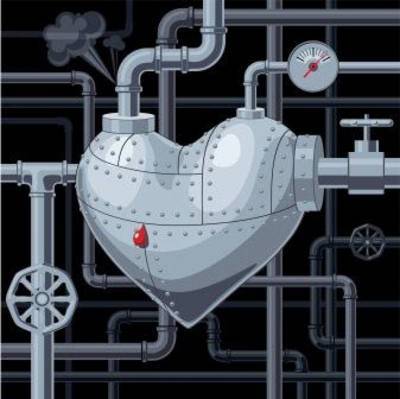All too often businesses, from SMEs to major corporations, forget the importance of their warehouse operations as a critical part of the supply chain. The warehouse is often taken for granted and neglected in terms of investment and consideration within the overall supply chain strategy. The simple truth however, is that the warehousing operation within most businesses can be a key factor in either the success or failure of the supply chain. Quickly think out everything within the supply chain that impacts the warehouse operation, or that the warehouse operation has an impact on, and it will soon become apparent how important it is.
Consider the analogy that the warehouse in the supply chain is much like the heart in the human body.
 The heart is just a pump, a complex and important one, yes, but still just a pump. It receives oxygen depleted blood from the body (raw material suppliers), pumps it out to the lungs (processing/production plant) and distributes oxygenated blood (finished goods) received from the lungs (processing/production plant) throughout the rest of the body – much like the warehouse receiving and distributing product from and throughout the supply chain.
The heart is just a pump, a complex and important one, yes, but still just a pump. It receives oxygen depleted blood from the body (raw material suppliers), pumps it out to the lungs (processing/production plant) and distributes oxygenated blood (finished goods) received from the lungs (processing/production plant) throughout the rest of the body – much like the warehouse receiving and distributing product from and throughout the supply chain.
Everyone knows that the heart is a vital organ; after all it pumps approximately 9,000 litres of blood around the body per day. However, as with all pumps it can become clogged, break down and need repair. This is why it is critical that we know how the heart works – as what is good or bad for it can significantly impact the risk for failure.
So in this analogy of warehouse and heart, why on so many occasions is so little time spent looking after either, usually until it is too late?
The answer is that the warehouse (heart) within the supply chain (body) is seen as a functional necessity that has to service the needs of the rest of the departments within the business (organs), whereas its own needs to operate properly are not considered as important and are often overlooked.
For more information about warehousing and supply chain management get in touch with us on +44(0) 1926 430 883 or fill out a contact form online with your requirements.
The reality is that the warehouse needs investment in equipment, processes, systems and resource (much like the heart requiring an independent supply of oxygen and nutrients) and a strategy to ensure this happens as other parts of the business change needs to be put in place.
Cutting the warehouse investment and expenditure budget as a means of cost cutting to increase business efficiency is a false economy which is repeated year after year. I am frequently told when visiting companies that to date the warehouse has not been a priority for them and that they have invested in all parts of the business except the warehouse, which is no longer operating efficiently nor meeting the needs of the business. On further inspection that same warehouse will probably hold too much inventory (including obsolete stock), will not have a fully functional Warehouse Management System (WMS), will have either out of date or no Standard Operating Procedures (SOPs), will have an out dated layout and more than likely have outdated handling equipment.
These issues are a result of other parts of the business having investment and revised strategy to improve products, systems and operations without giving any thought to the impact on the warehouse, other than that it will have to cope with whatever is needed.
 Remember; think of everything within the supply chain that impacts the warehouse operation, or that the warehouse operation has an impact on. For example; procurement strategy will have a direct impact on inventory holding (and therefore space requirements) and sometimes even the location of the warehouse; new product introduction will directly impact the type of inventory and could also directly impact the warehouse processes, layout, equipment and handling requirements; sales and marketing campaigns create seasonal peaks and directly impact the flow of product and therefore the resource requirements throughout the warehouse; and the most common of all being IT strategy to implement a new ERP system, which has limited or no WMS functionality and simply has a stock level function. Any of these examples can have a negative effect on warehouse performance and consequently a direct negative impact on order fulfilment and customer service levels being achieved.
Remember; think of everything within the supply chain that impacts the warehouse operation, or that the warehouse operation has an impact on. For example; procurement strategy will have a direct impact on inventory holding (and therefore space requirements) and sometimes even the location of the warehouse; new product introduction will directly impact the type of inventory and could also directly impact the warehouse processes, layout, equipment and handling requirements; sales and marketing campaigns create seasonal peaks and directly impact the flow of product and therefore the resource requirements throughout the warehouse; and the most common of all being IT strategy to implement a new ERP system, which has limited or no WMS functionality and simply has a stock level function. Any of these examples can have a negative effect on warehouse performance and consequently a direct negative impact on order fulfilment and customer service levels being achieved.
The warehouse operations need to have visibility of the whole business and be part of the overall and on-going logistics and supply chain strategy, with cause and effect being identified with each change within the supply chain. However there is little or no point in integrating an out of date or inappropriate warehouse operation into the business strategy.
The starting point is to optimise your existing warehouse operations to meet the current and future needs of the business, in line with your growth projections. The key areas that need to have an established strategy are an appropriate warehouse and inventory management technique (to optimise workflow and costs); optimised target inventory (holding cost vs ordering cost vs service); optimised warehouse design/stores layout, handling practices and workflows; tactical stock location(s) and picking strategy; appropriate manual and/or automated Materials Handling Systems; a clear WMS operational requirement specification; a performance measurement strategy (and/or tool), to identify activity costs within the warehouse and customer service performance.
This may make you think that simply outsourcing your warehouse to one of the many third party providers would be an easier option to have as your ‘instant’ optimisation strategy. However, this is not the right approach if you do not understand your current warehouse operations and therefore warehouse requirements in detail. (Would you consider having an artificial heart before you were aware of all the facts and the options available to you?).
To outsource you must have a clear understanding of exactly what you are outsourcing, how to measure the performance of your provider and how the costs of outsourcing compare to the costs of running your own optimised warehouse. I am a keen advocate of outsourcing many warehouse and logistics operations and frequently do so for companies across the UK and Europe when it is appropriate and there is a clear understanding of the business needs with a clear strategy.
To develop a good warehouse strategy (whether in-house or outsourced) you will need to review your current operation and understand the type of operation you will need in the future as the business changes. This will include a full review of the following areas; the interface/interaction between warehousing and other  operations/departments; product flows and volumes at SKU or family level; seasonal fluctuations for each product group; increased product lines and projected changes to product family type; product storage requirements, including number on pallets, outer packaging, cartons, SKU and items; goods in and put-away/stowage routines and picking, packing and despatch procedures; stock and inventory management requirements; inbound product profiles and handling requirements; customer service and delivery commitments and order cut-off times; stock and inventory data to determine stock levels and pick face layouts; returns handling and sortation operation; slow moving and obsolete stock policy; stock management system or WMS and reporting requirements; warehouse operational costs.
operations/departments; product flows and volumes at SKU or family level; seasonal fluctuations for each product group; increased product lines and projected changes to product family type; product storage requirements, including number on pallets, outer packaging, cartons, SKU and items; goods in and put-away/stowage routines and picking, packing and despatch procedures; stock and inventory management requirements; inbound product profiles and handling requirements; customer service and delivery commitments and order cut-off times; stock and inventory data to determine stock levels and pick face layouts; returns handling and sortation operation; slow moving and obsolete stock policy; stock management system or WMS and reporting requirements; warehouse operational costs.
Once you have acknowledged that your warehouse is at the heart of your supply chain, combined with an understanding of how it should work, and subsequently implement a strategy to maintain its health and longevity; then the hard work is done.
Remember a business will rarely die of a broken heart, but the longer you take to address the cause of the heartache, the longer the negative impact and effects can last.
For more information about warehousing and supply chain management get in touch with us on +44(0) 1926 430 883 or fill out a contact form online with your requirements.














